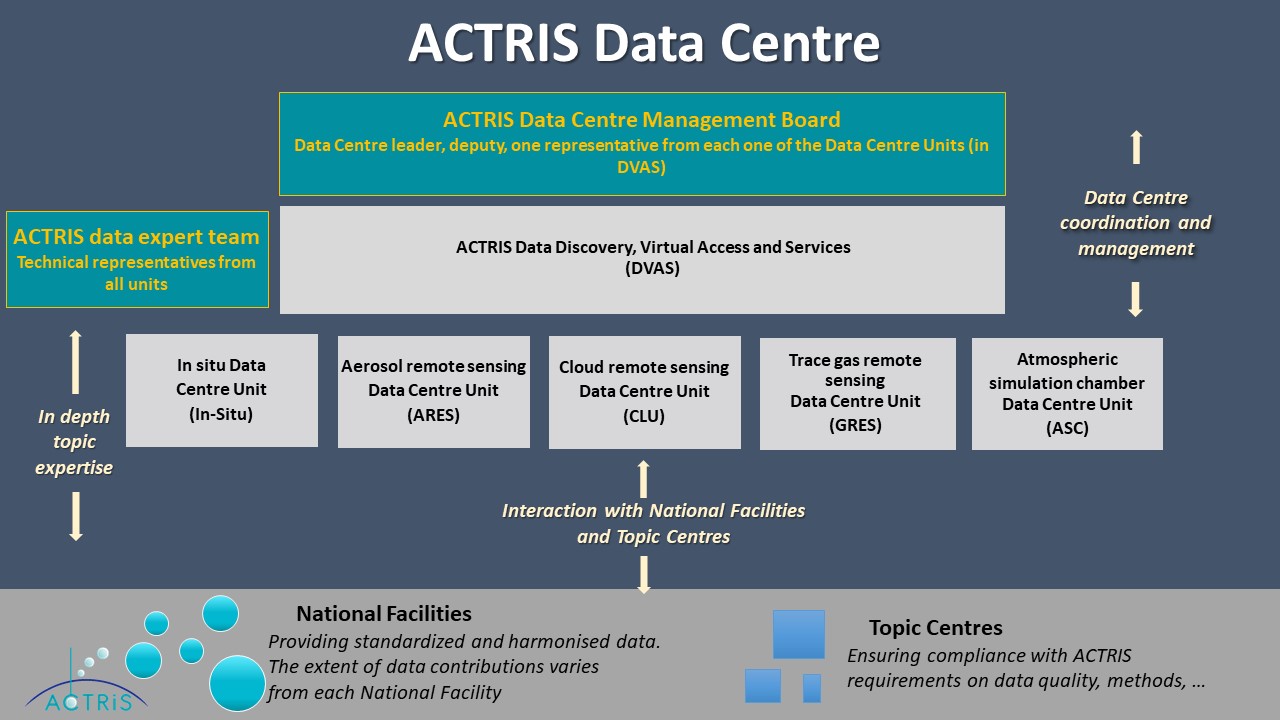Mission of the ACTRIS Data Centre
The mission of the ACTRIS Data Centre (DC) is to compile, archive and provide access to well documented and traceable ACTRIS measurement data and data products, including digital tools for data quality control, analysis, visualisation, and research.
As a tool for science, the highest priorities for the ACTRIS DC are to maintain and increase the availability of ACTRIS data and data products relevant to climate and air quality research for all interested users.
What the ACTRIS Data Centre offers
The ACTRIS Data Centre provides scientists and other user groups with free and open access to all ACTRIS data, complemented with access to innovative and mature data products, together with tools for quality assurance (QA), data analysis and research.
- ACTRIS Data portal
- ACTRIS Data services and products
Variables & measurement techniques
Almost 135 different atmospheric variables are measured within ACTRIS. The measurements are done with 25 different methodologies with time resolution ranging from seconds to 1 week. The ACTRIS data management plan includes a list with all ACTRIS atmospheric variables and describes the data, data products, and how data are made available. This is also described in detail in Bulletin of the American Meteorological Society (BAMS) by Laj et al. in 2024.
ACTRIS measurements comply with well-described measurement guidelines and standard operating procedures (SOPs). Comparable data from different observational platforms and sites are crucial for the detection of trends or slight variations in chemical composition of the atmosphere. In many cases, decades of time series are required to assess these changes with a certain degree of confidence. Comparable methods and traceable data and quality are essential. Many of ACTRIS' SOPs are implemented in other frameworks, on both European (EMEP) and international (GAW) scale.
The ACTRIS reference paper in BAMS provides more information on all aspects.
Our Team & Units
ACTRIS Data Centre is a distributed data centre. It is organized in six units, i.e. five units (In-Situ, ARES, CLU, GRES, ASC) with complementary topic expertise and one unit with integrating activities (DVAS). There are clear links and procedures for interaction between the data centre Units, National Facilities (NFs) and topical centres (TCs).

The ACTRIS Data Centre is coordinated by the DVAS unit leader and all data is made available through the ACTRIS data portal serving as the access point to data and all related information. Furthermore, the data centre work is organized in the ACTRIS data management board and the ACTRIS data expert team. The role of the ACTRIS DC Management Board is to ensure that the ACTRIS DC as a whole operates in a coordinated and coherent manner. The ACTRIS Data Expert Team is a transversal technical group with representatives of all the DC topic units. Contact persons, members and leading roles are described in the ACTRIS data portal - About section.
- DVAS - Data Discovery, Virtual Access and Services unit
-
The ACTRIS Data Discovery, Virtual Access and Services unit (DVAS) is responsible for organising access to measurement data from the topic data centre units, and documentation of procedures as support to observational and exploratory NFs. The DVAS unit provides the ACTRIS web interface for data download, services and digital tools as well as performing data production of Level 3 data, and synergy data products.
The DVAS web interface, so called “The ACTRIS Data Centre”, incldues a searchable metadata catalogue as well as other services. The main activities are Discovery and access to ACTRIS data and data products, overview of digital tools provided by the topical centres and the data centre units, documentation, software and tools for data production. Visualisation of ACTRIS data products. Data production of Level 3 data using synergistic and integrated data. The data centre also offers bridge to external data bases and sources.
The ACTRIS DVAS unit offer acecss to elaborated aerosol, cloud and trace gas data products, issued of advanced multi-instrument synergistic algorithms, long term reanalysis, modelling and satellite data and sources. These can be produced within the DVAS unit, topic data centre units, topic centres, or external contributions.
Contact: Cathrine Lund Myhre, NILU
Website: https://data.actris.eu/
- In-Situ - In Situ data centre unit
-
The In-Situ data centre unit provides data curation service for aerosol, cloud and trace gas in situ data, as well as archiving of this data using the EBAS database. This comprises tools for harmonized data submission and meta data templates, inclusion of data and meta data in the data base, documenting (meta)data traceability and provenance, harmonization and data versioning, quality control, archiving, documentation, data identification, and data provision. Training and online tools for QA/QC are offered. The activity enables RRT and NRT data collection, compilation and delivery, and provides tutorial activities.
The In-Situ data centre is hosted by the Norwegian Institute for Air Research (NILU).
Contact: Markus Fiebig, NILU
- ARES - Aerosol remote sensing data centre unit
-
The ARES data centre unit provides data curation and data processing service for aerosol remote sensing data coming from lidar and photometer observations. This includes centralized data processing, data storage, recording of metadata in a dedicated RDBMS, traceability, harmonization and data versioning, quality control, documentation and data provision. The unit allows for RRT and NRT data provisioning and offers support and training activities.
The main goal is providing access of high quality and document datasets of the aerosol optical properties vertical distribution in the whole troposphere and upper stratosphere with short time resolution.
The ARES DC unit is built on the heritage of the EARLINET data base infrastructure. The ARES infrastructure is maintained by the National Research Council of Italy.
Contact: Lucia Mona, CNR
- CLU - Cloud remote sensing data centre unit
-
The ACTRIS CLU data centre unit provides data curation and data processing service of cloud remote sensing data. This includes centralized processing, traceability, harmonization and data versioning, quality control, data provision and archiving, and documentation. The activity enables RRT and NRT data compilation and delivery, and participation in training.
The CLU data centre unit is making use of the so-called Cloudnet processing and archiving infrastructure, operated at the Finnish Meteorological Institute (FMI), Helsinki, Finland.
Contact: Ewan O'Connor, FMI
- GRES - Trace gases remote sensing data centre unit
-
The GRES data centre unit provides data curation service for reactive trace gases remote sensing data. This includes standardized process for metadata and data submission, traceability, data versioning, quality control, inclusion of data in the data base, data provision and archiving, and documentation. In addition, it offers production of level 3 for climatological analysis and added values products (quicklooks, links to EVDC-ESA Atmospheric Validation Data Centre).
The ACTRIS-GRES unit is structured in one unique database including measurements issued from five types of instruments:
- FTIR: Fourier Transform Infra-Red Spectrometry,
- UVVIS: Ultra-Violet and Visible spectroscopy including - UV-VIS ZS (zenith-sky) SAOZ (Sytème d’Analyse par Observation Zénithale) spectrometer, - UVVIS MAX-DOAS (Multi-AXis Differential Optical Absorption Spectroscopy instruments), - PANDORA instruments.
- LIDAR DIAL: Differential Absorption Lidar.
All data are stored in the GRES database which is hosted by the French data centre for atmospheric data AERIS.
Contact: Cathy - Boone, IPSL/CNRS
- ASC - Atmospheric simulation chamber data centre unit
-
The ASC data centre unit provides data curation service for data obtained from experiments in atmospheric simulation chambers (ACTRIS exploratory platforms). This includes tools for harmonized data and metadata submission, inclusion of data and metadata in the database, traceability, harmonization and data versioning, quality control, archiving, documentation and data provision. The ASC unit is structured in three pillars:
- The Database of Atmospheric Simulation Chamber Studies (DASCS) provides access to experimental data (level 2 data), typically time-series of measured parameters during an experiment in a simulation chamber.
- The Library of Analytical Resources (LAR) provides quantitative analytical resources that include infrared spectra and mass spectra of molecules and derivatives (level 3 data).
- The Library of Advanced Data Products (LADP) provides different types of mature data products (level 3 data): rate constants of reactions, quantum yields and photolysis frequencies of trace gas compounds, secondary organic aerosol (SOA) yields, mass extinction/absorption/scattering coefficients and complex refractive index of aerosols, growth factors of aerosols and modelling tools.
It is making use of EUROCHAMP database, which is hosted by AERIS infrastructure.
Contact: Bénédicte Picquet-Varrault, CNRS










